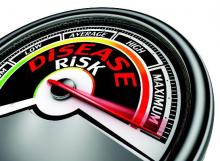Young, out-of-shape men were about three times more likely than physically fit men to develop type 2 diabetes later in life, even if their body weight was normal, reported the authors of a large registry study.
“These findings suggest that interventions to improve aerobic and muscle fitness levels early in life could help reduce risk for type 2 diabetes mellitus in adulthood,” Dr. Casey Crump, at the Icahn School of Medicine at Mount Sinai, New York, and his associates wrote in a study published online March 7 in Annals of Internal Medicine.
Future longitudinal studies of physical fitness could help identify “windows of susceptibility” and the best preventive measures, the researchers added.
A sedentary lifestyle is known to increase the risk of type 2 diabetes, but less is known about how physical fitness affects risk.
To explore the question, the researchers identified 1,534,425 men without baseline diabetes who underwent military conscription physical examinations between 1969 and 1997. They tracked the men until up to 62 years of age by analyzing both the Swedish Hospital Registry and the Swedish Outpatient Registry (Ann Intern Med. 2016 Mar 8; doi: 10.7326/M15-2002).
In all, 34,008 men developed type 2 diabetes over 39.4 million years of follow-up, the investigators said. Both low cardiorespiratory fitness and low muscle strength independently increased the risk for type 2 diabetes, regardless of whether the men had a high or normal body weight.
Moreover, the combination of low cardiorespiratory fitness and poor muscular fitness increased type 2 diabetes risk threefold (adjusted hazard ratio, 3.07; 95% confidence interval, 2.88 to 3.27; P less than .001), with a positive additive interaction (P less than .001).
Accounting for smoking lowered the associations between poor baseline fitness and type 2 diabetes by about 9%; but they remained significant (P less than .001), suggesting that unmeasured confounding “had little influence on our main findings,” the investigators said. If the associations are causal, then aerobic conditioning programs targeting men with low muscle strength might have the greatest public health impact, they added.
The U.S. National Institutes of Health, the Swedish Research Council, and Region Skåne/Lund University funded the study. The researchers had no disclosures.


